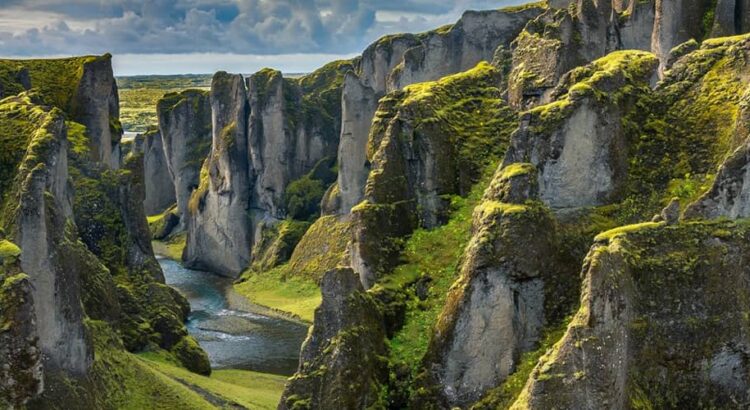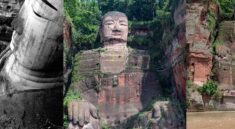Iceland is known for its stunning canyons, carved by glacial rivers and surrounded by breathtaking landscapes. Some of the famous Icelandic canyons include Fjaðrárgljúfur, Ásbyrgi, and Jökulsárgljúfur. These canyons offer hiking opportunities, unique geological formations, and the chance to immerse yourself in Iceland’s natural beauty.
How to get there
To visit Iceland’s canyons, you’ll need to plan your trip and make your way to the specific canyon you wish to explore. Here’s a general guide on how to get to Iceland’s canyons:
- Plan Your Itinerary: Research and decide which canyon(s) you want to visit. Iceland has several canyons, each with its unique characteristics and location.
- Rent a Vehicle: Renting a vehicle, such as a car or campervan, is the most flexible way to explore Iceland’s canyons. You can rent a vehicle from major cities like Reykjavik or Akureyri. Make sure to choose a vehicle suitable for the terrain, especially if you plan to visit canyons in remote areas.
- Map and Navigation: Ensure you have a reliable map or GPS device to navigate Iceland’s roads, as some canyons may be in remote or less-traveled areas. GPS navigation is essential, especially for off-the-beaten-path locations.
- Road Conditions: Check road conditions and closures, especially if you plan to visit during the winter months when some roads may be impassable or require four-wheel-drive vehicles.
- Permits and Regulations: Some canyons may have entry fees or require permits, especially if they are within protected areas like national parks. Check in advance and obtain any necessary permits.
- Guided Tours: If you prefer a guided experience or are not comfortable driving in Iceland’s challenging conditions, consider booking a guided tour to the canyon of your choice. There are many tour operators offering guided excursions to popular destinations.
- Accommodations: Depending on the location of the canyon, you may need to arrange accommodations nearby. Iceland offers a range of accommodation options, from hotels to campsites.
- Weather and Safety: Keep an eye on the weather forecast, as conditions can change rapidly in Iceland. Dress appropriately for the climate, and always prioritize safety during your visit.
- Respect the Environment: Be mindful of the environment and follow Leave No Trace principles. Stay on designated trails, dispose of waste properly, and respect any regulations in place to protect the natural surroundings.
By planning your trip carefully and taking the necessary precautions, you can enjoy the stunning beauty of Iceland’s canyons and have a memorable outdoor adventure.
Things to do
When visiting Iceland’s canyons, you can enjoy a range of outdoor activities and experiences amid the stunning natural landscapes. Here are some things to do when exploring Iceland’s canyons:
- Hiking: Many canyons offer hiking trails with varying difficulty levels. Hiking allows you to explore the canyon’s unique features, enjoy scenic views, and get up close to the natural surroundings.
- Photography: Iceland’s canyons are known for their picturesque beauty. Capture the stunning landscapes, rock formations, and the interplay of light and shadows through your camera lens.
- Birdwatching: Iceland is home to a variety of bird species, and canyons often provide opportunities for birdwatching. Keep an eye out for puffins, seabirds, and other feathered inhabitants.
- Canyon Exploration: Depending on the canyon, you may be able to explore the canyon itself, including its rock formations, caves, and unique geological features. Always prioritize safety and adhere to any regulations.
- Wildlife Viewing: Beyond birds, you might encounter other wildlife in the area, such as reindeer, seals, and Arctic foxes. Wildlife photography and observation can be rewarding.
- Picnicking: Pack a picnic and enjoy a meal surrounded by the canyon’s natural beauty. Many canyons have designated picnic areas where you can relax and savor the moment.
- Guided Tours: Consider joining a guided tour of the canyon to learn about its geological history, local flora and fauna, and cultural significance. Guided tours often provide insights you might miss on your own.
- Rock Climbing and Bouldering: If you’re an experienced climber, some canyons offer rock climbing opportunities. Be sure to check local regulations and safety guidelines.
- Stargazing: In remote areas away from city lights, Iceland offers excellent stargazing opportunities. On clear nights, you can marvel at the northern lights (Aurora Borealis) if you visit during the right season.
- Environmental Conservation: Be a responsible visitor by following Leave No Trace principles. Respect the environment, stay on designated paths, and avoid disturbing wildlife.
Remember that Iceland’s weather can change quickly, so always be prepared with appropriate clothing, water, and provisions for your outdoor adventures. Enjoy your time exploring the canyons and the stunning natural beauty that Iceland has to offer.
Things not to forget
When visiting Iceland’s canyons, it’s important to be well-prepared to ensure a safe and enjoyable experience. Here are some essential things not to forget:
- Weather-Appropriate Clothing: Iceland’s weather can be unpredictable, even in summer. Pack waterproof and windproof clothing, as well as layers to stay warm and dry.
- Sturdy Footwear: Comfortable and waterproof hiking boots with good traction are essential for exploring the terrain around canyons.
- Navigation Tools: Carry a reliable GPS device or smartphone with offline maps to navigate to and within the canyons.
- Safety Gear: Depending on your activities, bring safety gear such as a first-aid kit, headlamp, and whistle.
- Water and Snacks: Stay hydrated by carrying an adequate supply of water, and bring energy-boosting snacks for your hikes.
- Travel Insurance: Make sure you have comprehensive travel insurance that covers activities and potential emergencies in Iceland.
- Permits and Documentation: If required, obtain any necessary permits for visiting protected areas or canyons. Keep identification and important documents in a waterproof pouch.
- Cash: Some remote areas in Iceland may not have electronic payment options, so it’s a good idea to carry some cash for small purchases.
- Camera and Binoculars: Capture the stunning landscapes and wildlife with your camera or smartphone, and binoculars for wildlife spotting.
- Respect for the Environment: Follow Leave No Trace principles by packing out all trash, staying on designated trails, and respecting local regulations.
- Emergency Contacts: Carry contact information for local emergency services and your embassy or consulate in case of emergencies.
- Rechargeable Power Bank: Ensure your devices stay charged by bringing a portable power bank, especially if you plan to use GPS or photography apps.
- Local Currency: While credit cards are widely accepted, it’s helpful to have some local currency for small purchases or in case of card payment issues.
- Backpack: A comfortable and waterproof backpack is useful for carrying your essentials during hikes.
- Local Maps and Guidebooks: Physical maps and guidebooks can be helpful for trip planning and navigation.
- Language Assistance: If you’re not fluent in Icelandic, consider a language translation app or a pocket-sized phrasebook.
- Entertainment: For long drives or downtime, bring a book, music, or other forms of entertainment.
By being well-prepared and organized, you’ll be ready to fully enjoy your adventure in Iceland’s canyons while ensuring your safety and comfort.
Best time to visit
The best time to visit Iceland’s canyons depends on your preferences and the activities you plan to do. Here are the main seasons and factors to consider:
- Summer (June to August):
- Weather: Summer offers the mildest weather in Iceland, with longer daylight hours. It’s an excellent time for hiking and outdoor exploration.
- Wildlife: Summer is the best time for birdwatching, as many species migrate to Iceland during this season.
- Accessibility: Most roads and hiking trails are open and accessible during the summer, including those leading to canyons.
- Autumn (September to October):
- Fall Colors: If you enjoy fall foliage, this is a beautiful time to visit as the landscape takes on vibrant colors.
- Fewer Crowds: Compared to the peak summer season, you’ll encounter fewer tourists during the autumn months.
- Winter (November to February):
- Northern Lights: Winter is prime time for witnessing the Northern Lights (Aurora Borealis) in Iceland, including near some canyons.
- Snow and Ice: The canyons and surrounding landscapes can be covered in snow and ice, creating a magical winter wonderland.
- Challenging Conditions: Winter weather can be harsh, with shorter daylight hours, colder temperatures, and challenging driving conditions.
- Spring (March to May):
- Milder Weather: Spring offers milder weather compared to winter, making it a good time for outdoor activities.
- Wildlife: Birdwatching opportunities begin as migratory birds return to Iceland.
- Thawing Landscapes: As the snow and ice start to melt, you can witness the transformation of the landscape.
Ultimately, the best time to visit Iceland’s canyons depends on your interests and the experiences you seek. Summer provides the most comfortable weather for hiking and outdoor activities, while winter offers the chance to see the Northern Lights. Spring and autumn offer a balance between mild weather and unique seasonal experiences. Consider your priorities and plan your visit accordingly.
What is the famous canyon in Iceland?
The famous canyon in Iceland is Fjaðrárgljúfur. It is renowned for its stunning natural beauty, towering cliffs, meandering river, hiking trails, lush vegetation, and its popularity among photographers. Fjaðrárgljúfur Canyon’s dramatic scenery and unique geological formations make it a must-visit destination for travelers exploring Iceland’s landscapes.
What is the canyon in Iceland with water?
One of the canyons in Iceland that features water flowing through it is Fjaðrárgljúfur Canyon. This canyon is known for its meandering river that flows along its floor, adding to the scenic beauty of the landscape. Fjaðrárgljúfur is famous for its dramatic cliffs, lush vegetation, and unique geological features, making it a popular destination for travelers and photographers. The river’s presence enhances the overall charm of this stunning canyon in Iceland.
What created the canyons in Iceland?
The canyons in Iceland, including popular ones like Fjaðrárgljúfur and Ásbyrgi, were primarily formed by the erosional forces of water. The unique geological processes that created these canyons include the following:
- Glacial Rivers: Iceland is known for its numerous glacial rivers that flow from the country’s ice caps and glaciers. These powerful rivers carry meltwater and sediment, which erode the volcanic rock and create deep channels over time.
- Lava and Tectonic Activity: Iceland is situated on the Mid-Atlantic Ridge, a tectonic boundary where the Eurasian and North American tectonic plates meet. Volcanic activity and tectonic forces have shaped the landscape, leading to the formation of deep fissures, valleys, and canyons.
- Erosion and Geological Time: Over thousands of years, the combination of glacial rivers, lava flows, and geological forces has slowly carved out the canyons. Water erosion, especially during the spring thaw and heavy rainfall, plays a significant role in deepening and shaping these canyons.
- Landscape Diversity: Iceland’s diverse landscapes, including volcanic rock formations, plateaus, and glacial valleys, provide a range of geological features that contribute to the formation of canyons.
Overall, the canyons in Iceland are the result of complex geological processes driven by water, volcanic activity, and tectonic forces over millions of years. They stand as natural wonders that showcase the country’s unique geology and natural beauty.
What is the history of the fjaðrárgljúfur canyon?
The history of Fjaðrárgljúfur Canyon in Iceland is primarily geological, spanning millions of years. The canyon’s formation is the result of natural processes and changes in the Earth’s landscape. While there isn’t a human history associated with the canyon in the traditional sense, its geological history is fascinating:
- Volcanic Activity: Fjaðrárgljúfur Canyon is located in a region of Iceland that has been shaped by extensive volcanic activity. The canyon itself was created through a combination of volcanic eruptions and subsequent erosion.
- Glacial Influence: Over time, glacial rivers, including the Fjaðrá River, have flowed through the area and eroded the volcanic rock, gradually deepening and shaping the canyon.
- Geological Time: The formation of Fjaðrárgljúfur Canyon spans millions of years, with the forces of erosion, water, and geological activity continually shaping and reshaping the landscape.
- Natural Beauty: Today, Fjaðrárgljúfur Canyon is known for its stunning natural beauty, towering cliffs, meandering river, lush vegetation, and unique geological features. It has become a popular destination for travelers and photographers.
While there isn’t a specific historical narrative or cultural history associated with Fjaðrárgljúfur Canyon, its geological history and its role as a natural wonder in Iceland make it a significant and visually captivating location.
Image credits: bluecarrental.is





